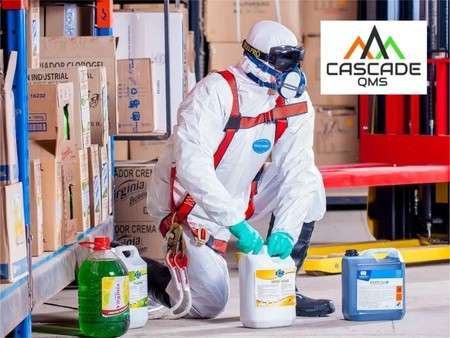What is HAZWOPER
A Hazardous Waste Operations and Emergency Response (HAZWOPER) safety plan is essential for any small business that handles hazardous materials. These types of materials can be found in many industries, including construction, manufacturing, transportation, and healthcare, to name a few.
What are Hazardous Materials?
Hazardous materials can be anything from chemicals, pesticides, radioactive materials, and biological waste. These materials can cause serious harm if not handled properly, which is why it is crucial for small businesses to have a plan in place to manage them safely. A well-designed HAZWOPER safety plan helps to minimize the overall risk of accidents and injuries, not only to employees but also to the general public and the environment.
Types of Hazardous Materials
There are several types of hazardous materials that can be found in various industries. Some examples include:
-
Chemicals: These can include acids, bases, solvents, and other industrial chemicals that can be toxic, flammable, or corrosive.
-
Pesticides are chemicals used to control pests and can be toxic to humans and animals.
-
Radioactive materials: These can include uranium, plutonium, and other radioactive elements used in nuclear power plants and different industrial settings.
-
Biological waste: This can include medical waste, such as sharps, or natural materials exposed to pathogens.
-
Asbestos: A naturally occurring mineral that can cause lung cancer and mesothelioma if inhaled.
-
Lead: A heavy metal that can cause serious health problems, especially in children.
-
Polychlorinated biphenyls (PCBs): A group of chemicals widely used in electrical equipment and other industrial applications.
-
Oil and gasoline are flammable liquids that can be dangerous if spilled or not handled properly.
-
Explosives: This can include dynamite, TNT, and other materials that can detonate if not appropriately handled.
-
Compressed gases: These can include propane, acetylene, and other gases stored under high pressure and can be dangerous if not handled properly.
This is not an exhaustive list; many other hazardous materials can be found in different industries. Businesses need to identify what type of hazardous materials they work with and have a safety plan to handle them safely.
One of the main reasons why a HAZWOPER safety plan is so important is that it helps protect employees’ health and safety. These plans outline procedures for responding to emergencies and managing hazardous waste. They are required by the Occupational Safety and Health Administration (OSHA) for businesses that fall under its jurisdiction. Small companies are legally required to have a HAZWOPER safety plan, meaning non-compliance can result in severe penalties, fines, and even legal action.
HAZWOPER Safety Statistics
There are a variety of statistics available on injuries related to hazardous waste operations and emergency response (HAZWOPER) in the United States. However, it should be noted that these statistics may not be entirely up-to-date and may not take into account all HAZWOPER-related injuries and incidents.
According to data from the Occupational Safety and Health Administration (OSHA), in 2019, there were an estimated 2,080 non-fatal occupational injuries and illnesses in the private sector that involved exposure to hazardous substances. Of these, 1,260 (60.4%) were classified as “cases with days away from work, job transfer, or restriction.”
Additionally, the Bureau of Labor Statistics (BLS) reported that in 2019, there were an estimated 70 fatal work injuries caused by exposure to harmful substances or environments, which includes hazardous materials.
A study by the National Institute for Occupational Safety and Health (NIOSH) in the year 2000 found that:
-
The incidence rate of injury and illness among HAZWOPER workers was higher than that of workers in all industries combined.
-
The most common types of injuries among HAZWOPER workers were cuts, punctures, sprains, and strains.
-
The most common types of illnesses among HAZWOPER workers were respiratory disorders and skin disorders.
It’s important to note that these statistics may not fully reflect the scope of HAZWOPER-related injuries and illnesses, as many incidents may go unreported or not be captured in data from the Bureau of Labor Statistics or Occupational Safety and Health Administration.
It is clear from the statistics that the handling of hazardous materials can be a dangerous task, and it is important to take the necessary precautions to prevent injuries and accidents in the workplace. Having a well-designed HAZWOPER safety plan in place and providing proper training to employees can help to minimize the risk of injuries and illnesses.
Hazwoper Compliance
Another critical aspect of a HAZWOPER safety plan is that it helps to ensure compliance with federal and state regulations. As mentioned earlier, OSHA has strict rules and guidelines for handling hazardous materials, and failure to comply with these regulations can result in significant fines and penalties. By having a solid safety plan in place, small businesses can avoid costly compliance issues and ensure that they operate according to all relevant laws and regulations.
Comprehensive and company specific HAZWOPER safety programs are almost always required to gain compliance for prequalifications and in major vetting systems such as ISNetworld®, Veriforce® and Avetta®. Cascade QMS programs are written to satisfy all major vetting system requirements.
What should a HAZWOPER safety program include?
A HAZWOPER safety plan should include procedures for identifying and assessing hazards and protocols for emergency response and evacuation. It should also outline procedures for the storage, transportation, and disposal of hazardous materials and specify employees’ roles and responsibilities in the event of an emergency. This includes identifying emergency contact information, emergency evacuation routes, and emergency response teams.
Creating a HAZWOPER safety plan can be a complex process, and it is essential to work with experienced professionals to ensure that it meets all relevant regulations and standards. This may include consulting with OSHA officials, hazardous materials experts, and other professionals. Cascade QMS are professionals who can provide guidance and support. These experts can also train employees on handling hazardous materials safely and responding to emergencies.
HAZWOPER, you need it!
A HAZWOPER safety plan is crucial for small businesses that handle hazardous materials. It helps to protect the health and safety of employees, and ensures compliance with federal and state regulations. Hazwoper’s also provide a framework for responding to emergencies. Having a HAZWOPER safety plan in place can also give customers peace of mind. Peace of mind knowing that the small business is operating safely and responsibly. By devoting time to developing a robust and comprehensive safety plan, small businesses can minimize the risk of accidents. More so, they can protect themselves from costly compliance issues.
Cascade QMS is available and ready to customize a HAZWOPER Safety Plan for your business quickly. Our written safety programs are designed to enhance your safety culture and aid in compliance activities. Let’s chat!

